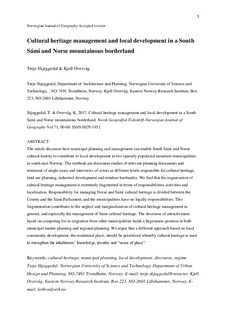| dc.contributor.author | Skjeggedal, Terje | |
| dc.contributor.author | Overvåg, Kjell | |
| dc.date.accessioned | 2018-03-09T07:53:31Z | |
| dc.date.available | 2018-03-09T07:53:31Z | |
| dc.date.created | 2017-03-16T15:42:20Z | |
| dc.date.issued | 2017 | |
| dc.identifier.citation | Norsk Geografisk Tidsskrift. 2017, 71 (1), 30-45. | nb_NO |
| dc.identifier.issn | 0029-1951 | |
| dc.identifier.uri | http://hdl.handle.net/11250/2489641 | |
| dc.description.abstract | The article discusses how municipal planning and management can enable South Sámi and Norse cultural history to contribute to local development in two sparsely populated mountain municipalities in south-east Norway. The authors’ methods comprised document studies of relevant planning documents and treatment of single cases, and interviews with actors at different levels, who were responsible for cultural heritage, land use planning, industrial development and reindeer husbandry. The findings revealed that the organization of cultural heritage management was extremely fragmented in terms of responsibilities, activities and localization. Responsibility for managing Norse and Sámi cultural heritage is divided between counties and the Sámi Parliament, and the municipalities have no legal responsibilities. This fragmentation contributes to the neglect and marginalization of cultural heritage management in general, and especially the management of Sámi cultural heritage. The discourse of attractiveness based on competing for in-migration from other municipalities holds a hegemonic position in both municipal master planning and regional planning. The authors conclude that a different approach based on local community development, namely the residential place, should be prioritized, whereby cultural heritage is used to strengthen the inhabitants’ knowledge, identity and ‘sense of place’. | nb_NO |
| dc.language.iso | eng | nb_NO |
| dc.publisher | Taylor & Francis | nb_NO |
| dc.title | Cultural heritage management and local development in a South Sámi and Norse mountainous borderland | nb_NO |
| dc.type | Journal article | nb_NO |
| dc.type | Peer reviewed | nb_NO |
| dc.description.version | acceptedVersion | nb_NO |
| dc.source.pagenumber | 30-45 | nb_NO |
| dc.source.volume | 71 | nb_NO |
| dc.source.journal | Norsk Geografisk Tidsskrift | nb_NO |
| dc.source.issue | 1 | nb_NO |
| dc.identifier.doi | 10.1080/00291951.2017.1290674 | |
| dc.identifier.cristin | 1458855 | |
| dc.description.localcode | Locked until 23.8.2018 due to copyright restrictions. This is an [Accepted Manuscript] of an article published by Taylor & Francis in [Norsk Geografisk Tidsskrift - Norwegian Journal of Geography ] on [23 Feb 2017], available at https://www.tandfonline.com/doi/full/10.1080/00291951.2017.1290674 | nb_NO |
| cristin.unitcode | 194,61,50,0 | |
| cristin.unitname | Institutt for arkitektur og planlegging | |
| cristin.ispublished | true | |
| cristin.fulltext | postprint | |
| cristin.qualitycode | 1 | |
